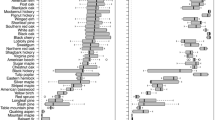Abstract
Weinvestigated the effect of habitat loss on the ability of trees to shift in distribution across a landscape dominated by agriculture. The potential distribution shifts of four tree species (Diospyros virginiana, Oxydendron arboreum, Pinus virginiana, Quercus falcata var. falcata) whose northern distribution limits fall in the southern third of Ohio were used to assess possible distribution shift scenarios as a result of global warming. Our predictions derive from the results of simulations using (a) forest inventory based estimates of current distribution and abundance of target species; (b) a satellite-based estimate of forest habitat availability; and (c) a tree migration model (SHIFT). The current distribution and abundance of trees was estimated using USDA Forest Service's Forest Inventory Analysis data and distribution maps from the late 1960s; pre-European settlement forest–nonforest maps were used to represent the fully forested condition for calibration and comparison. Habitat-availability estimates in Ohio were estimated using classified Landsat Thematic Mapper (TM) data from 1994. Tree abundance, forest availability and migration were modeled using a 1-km2 pixel size. Forest availability was estimated as the proportion of forested TM pixels within each cell. The probability of a migrating species colonizing an unoccupied cell is modeled as a function of forest availability and distance to occupied cells. The results of the migration models suggest that the species studied are capable of colonizing virtually any forested location within Ohio over the next 100 years if climatic controls over the current distribution that may currently inhibit northward movement are relaxed. The contiguous distribution of these species, however, is not likely to shift more than 10 km during the next century regardless of the magnitude of the climate change. Examining the sensitivity of our simulations by varying critical model attributes, we found that whereas the variables controlling the amount of long-distance dispersal have strong effects on migration rates in the fully forested 1800 situation, they have significantly lesser effects on projections of future migration into highly fragmented forests. The low forest availability that characterizes much of the current Ohio landscape, along with the low likelihood of long distance dispersal, result in potential distribution shifts that are concentrated within the principally forested corridors in southeastern Ohio. We propose that in contrast to the past, future tree migrations are likely to be spatially and temporally correlated as a result of large climatic forcing and channelization through limited regions of available habitat. With respect to the management of biodiversity, this result suggests that it may be very difficult to discern plant migrations of native forest species owing to exceedingly slow rates of movement.
Similar content being viewed by others
Author information
Authors and Affiliations
Additional information
Received 19 September 2000; Accepted 2 March 2001.
Rights and permissions
About this article
Cite this article
Schwartz, M., Iverson, L. & Prasad, A. Predicting the Potential Future Distribution of Four Tree Species in Ohio Using Current Habitat Availability and Climatic Forcing. Ecosystems 4, 568–581 (2001). https://doi.org/10.1007/s10021-001-0030-3
Issue Date:
DOI: https://doi.org/10.1007/s10021-001-0030-3




